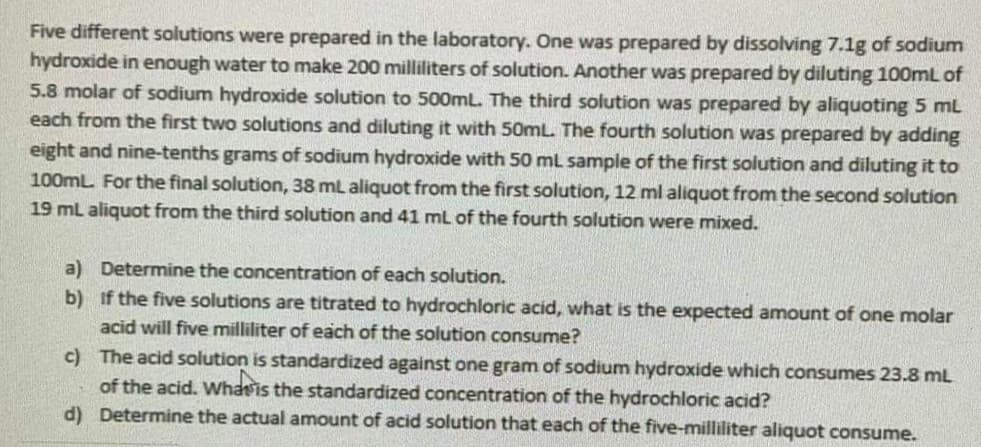Five different solutions were prepared in the laboratory. One was prepared by dissolving 7.1g of sodium hydroxide in enough water to make 200 milliliters of solution. Another was prepared by diluting 100mL of 5.8 molar of sodium hydroxide solution to 500mL. The third solution was prepared by aliquoting 5 mL each from the first two solutions and diluting it with 50mL. The fourth solution was prepared by adding eight and nine-tenths grams of sodium hydroxide with 50 mL sample of the first solution and diluting it to 100mL. For the final solution, 38 mL aliquot from the first solution, 12 ml aliquot from the second solution 19 mL aliquot from the third solution and 41 ml of the fourth solution were mixed. a) Determine the concentration of each solution. b) if the five solutions are titrated to hydrochloric acid, what is the expected amount of one molar acid will five milliliter of each of the solution consume? c) The acid solution is standardized against one gram of sodium hydroxide which consumes 23.8 mL of the acid. Whavis the standardized concentration of the hydrochloric acid?
Five different solutions were prepared in the laboratory. One was prepared by dissolving 7.1g of sodium hydroxide in enough water to make 200 milliliters of solution. Another was prepared by diluting 100mL of 5.8 molar of sodium hydroxide solution to 500mL. The third solution was prepared by aliquoting 5 mL each from the first two solutions and diluting it with 50mL. The fourth solution was prepared by adding eight and nine-tenths grams of sodium hydroxide with 50 mL sample of the first solution and diluting it to 100mL. For the final solution, 38 mL aliquot from the first solution, 12 ml aliquot from the second solution 19 mL aliquot from the third solution and 41 ml of the fourth solution were mixed. a) Determine the concentration of each solution. b) if the five solutions are titrated to hydrochloric acid, what is the expected amount of one molar acid will five milliliter of each of the solution consume? c) The acid solution is standardized against one gram of sodium hydroxide which consumes 23.8 mL of the acid. Whavis the standardized concentration of the hydrochloric acid?
Chemistry by OpenStax (2015-05-04)
1st Edition
ISBN:9781938168390
Author:Klaus Theopold, Richard H Langley, Paul Flowers, William R. Robinson, Mark Blaser
Publisher:Klaus Theopold, Richard H Langley, Paul Flowers, William R. Robinson, Mark Blaser
Chapter11: Solutions And Colloids
Section: Chapter Questions
Problem 8E: Solutions of hydrogen in palladium may be formed by exposing Pd metal to H2 gas. The concentration...
Related questions
Question

Transcribed Image Text:Five different solutions were prepared in the laboratory. One was prepared by dissolving 7.1g of sodium
hydroxide in enough water to make 200 milliliters of solution. Another was prepared by diluting 100mL of
5.8 molar of sodium hydroxide solution to 500mL. The third solution was prepared by aliquoting 5 mL
each from the first two solutions and diluting it with 50mL. The fourth solution was prepared by adding
eight and nine-tenths grams of sodium hydroxide with 50 ml sample of the first solution and diluting it to
100mL. For the final solution, 38 mL aliquot from the first solution, 12 ml aliquot from the second solution
19 ml aliquot from the third solution and 41 ml of the fourth solution were mixed.
a) Determine the concentration of each solution.
b) if the five solutions are titrated to hydrochloric acid, what is the expected amount of one molar
acid will five milliliter of each of the solution consume?
c) The acid solution is standardized against one gram of sodium hydroxide which consumes 23.8 mL
of the acid. Whasis the standardized concentration of the hydrochloric acid?
d) Determine the actual amount of acid solution that each of the five-milliliter aliquot consume.
Expert Solution
This question has been solved!
Explore an expertly crafted, step-by-step solution for a thorough understanding of key concepts.
Step by step
Solved in 4 steps

Knowledge Booster
Learn more about
Need a deep-dive on the concept behind this application? Look no further. Learn more about this topic, chemistry and related others by exploring similar questions and additional content below.Recommended textbooks for you

Chemistry by OpenStax (2015-05-04)
Chemistry
ISBN:
9781938168390
Author:
Klaus Theopold, Richard H Langley, Paul Flowers, William R. Robinson, Mark Blaser
Publisher:
OpenStax

Chemistry & Chemical Reactivity
Chemistry
ISBN:
9781337399074
Author:
John C. Kotz, Paul M. Treichel, John Townsend, David Treichel
Publisher:
Cengage Learning


Chemistry by OpenStax (2015-05-04)
Chemistry
ISBN:
9781938168390
Author:
Klaus Theopold, Richard H Langley, Paul Flowers, William R. Robinson, Mark Blaser
Publisher:
OpenStax

Chemistry & Chemical Reactivity
Chemistry
ISBN:
9781337399074
Author:
John C. Kotz, Paul M. Treichel, John Townsend, David Treichel
Publisher:
Cengage Learning


Chemistry
Chemistry
ISBN:
9781305957404
Author:
Steven S. Zumdahl, Susan A. Zumdahl, Donald J. DeCoste
Publisher:
Cengage Learning

Chemistry & Chemical Reactivity
Chemistry
ISBN:
9781133949640
Author:
John C. Kotz, Paul M. Treichel, John Townsend, David Treichel
Publisher:
Cengage Learning

Principles of Modern Chemistry
Chemistry
ISBN:
9781305079113
Author:
David W. Oxtoby, H. Pat Gillis, Laurie J. Butler
Publisher:
Cengage Learning